#Assamese traditional music
Photo

কৈলাস তালুকদাৰদেৱ (Kailash Talukdar) - দ্রোপদীৰ দর্পচূর্ণ (Dropdir darpchurn)
Region: India / Style: Assamese traditional / Year: ????
LOVED
4 notes
·
View notes
Link

Folk Music of Assam is equally rich like the state’s rich culture. Its richness can be very well noticed in its different types of folk music which reflects the life of the folk people.
https://www.indianetzone.com/79/folk_music_assam.htm
1 note
·
View note
Text
10 Offbeat Places in Assam
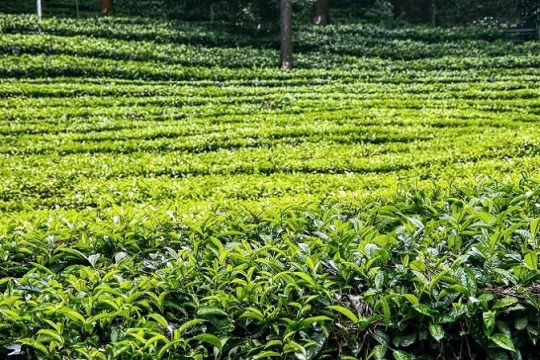
10 Offbeat Places in Assam
Assam, a beautiful state in Northeast India, is known for its tea gardens, wildlife sanctuaries, and stunning natural beauty. However, there are also some offbeat places in Assam that are worth visiting. Here are 10 of them:
Haflong: Located in the Dima Hasao district, Haflong is the only hill station in Assam. It offers beautiful views of the surrounding hills and valleys, and is a great place for trekking and camping.
Majuli: Majuli is the world's largest river island and is located on the Brahmaputra River. It is a cultural hub of Assam and is known for its traditional arts, crafts, and music.
Sivasagar: Sivasagar was the capital of the Ahom Kingdom and is home to several historical monuments such as the Rang Ghar, Talatal Ghar, and Kareng Ghar. It is also known for its traditional Assamese cuisine.
Manas National Park: Manas National Park is a UNESCO World Heritage site and is known for its diverse wildlife, including tigers, elephants, and rhinos. It is also home to several indigenous communities.
Digboi: Digboi is an oil town located in the Tinsukia district. It is home to the oldest operational oil refinery in Asia and is known for its colonial architecture and tea gardens.
Umananda Island: Umananda Island is located in the Brahmaputra River and is home to the Umananda Temple, dedicated to Lord Shiva. It is also a great place for birdwatching and river cruises.
Jatinga: Jatinga is a small village in the Dima Hasao district and is known for its mysterious bird suicides. Every year, during the months of August and September, several migratory birds are found dead in the village.
Hajo: Hajo is a pilgrimage site for Hindus, Muslims, and Buddhists. It is home to several ancient temples, mosques, and Buddhist stupas.
Pobitora Wildlife Sanctuary: Pobitora Wildlife Sanctuary is located in the Morigaon district and is known for its one-horned rhinoceroses. It is also home to several other species of wildlife such as leopards, wild boars, and deer.
Jorhat: Jorhat is a major city in Assam and is known for its tea gardens and golf courses. It is also home to several historical monuments such as the Gibbon Wildlife Sanctuary and the Dhekiakhowa Bornamghar.
Which city is very beautiful in Assam?
Assam is home to several beautiful cities, each with its own unique charm. However, if you are looking for a city that is known for its scenic beauty, then Guwahati is a great option. Located on the banks of the Brahmaputra River, Guwahati offers stunning views of the river and the surrounding hills. It is also home to several temples, parks, and wildlife sanctuaries, making it a great destination for nature lovers. Other beautiful cities in Assam include Jorhat, Tezpur, and Dibrugarh.
Which is the best place in Assam for picnic?
Assam has several beautiful places that are perfect for picnics. Here are a few options:
Pobitora Wildlife Sanctuary: Pobitora Wildlife Sanctuary is located in the Morigaon district and is known for its one-horned rhinoceroses. It is a great place for a picnic as it offers beautiful views of the grasslands and the wildlife.
Deepor Beel: Deepor Beel is a freshwater lake located near Guwahati. It is a popular spot for birdwatching and is a great place for a peaceful picnic.
Chandubi Lake: Chandubi Lake is a natural lake located in the Kamrup district. It is surrounded by hills and forests and is a great place for a picnic with family and friends.
Kakochang Waterfalls: Kakochang Waterfalls is located in the Jorhat district and is a popular picnic spot. The waterfall is surrounded by lush green forests and is a great place for a dip in the cool waters.
Hoollongapar Gibbon Wildlife Sanctuary: Hoollongapar Gibbon Wildlife Sanctuary is located in the Jorhat district and is home to several species of primates, including the Hoolock Gibbon. It is a great place for a picnic with a touch of wildlife adventure.
These are just a few of the many options for picnics in Assam. Be sure to check weather and safety conditions before planning a picnic in any location.
Which is the most visited place in Assam?
Assam is a beautiful state with several popular tourist destinations. However, the most visited place in Assam is Kaziranga National Park. This UNESCO World Heritage site is home to the world's largest population of one-horned rhinoceroses and is also home to tigers, elephants, and several other species of wildlife. The park is known for its beautiful landscapes and is a popular destination for wildlife enthusiasts, nature lovers, and photographers. Every year, thousands of tourists from around the world visit Kaziranga National Park to experience its natural beauty and wildlife.
Which place in Assam is the tourist keen?
Assam has several places that are popular among tourists. However, the place in Assam that tourists are most keen to visit is probably the Kaziranga National Park. This national park is home to the world's largest population of one-horned rhinoceroses and is also home to tigers, elephants, and several other species of wildlife. It is a UNESCO World Heritage site and is known for its beautiful landscapes and rich biodiversity. Tourists are often keen to visit Kaziranga National Park to experience its natural beauty and wildlife, and to participate in activities such as jungle safaris and birdwatching.
Which is Assam's only hill station?
Haflong is the only hill station in Assam. It is located in the Dima Hasao district, about 310 km south of Guwahati. Haflong is situated at an altitude of about 680 meters above sea level and is surrounded by hills, forests, and waterfalls. It is also home to several tribes such as the Dimasa, Hmar, and Zeme Nagas. The town is known for its scenic beauty, cool weather, and adventure activities such as trekking, hiking, and paragliding. Haflong is a great destination for those looking to escape the heat and enjoy some time amidst nature.
Where is the Butterfly Park in Assam?
The Butterfly Park in Assam is located in the Pobitora Wildlife Sanctuary. It is situated in the Morigaon district, about 50 km east of Guwahati. The Butterfly Park is a part of the Pobitora Wildlife Sanctuary and is dedicated to the conservation and breeding of various species of butterflies. The park has a wide range of plants and trees that are required for the breeding of butterflies. Visitors can see the various stages of butterfly development and learn about the different species of butterflies found in Assam. The Butterfly Park is a popular attraction in Assam, especially for nature lovers and those interested in wildlife conservation.
Read more
3 notes
·
View notes
Text
Discover Majuli Island: Embrace the Magic of River Life

AdminFebruary 22, 2024cheap flight tickets to India from USA, cheapest business class flights to India from USA, Last minute flight tickets to India, Majuli Island
Islands are lovely places where you can feel the wonder of nature enthrall you and time appears to stop. Rivers around Majuli Island in Assam, which is considered to be one of the most fascinating islands in all of India. It has magnificent fields, a pleasant surrounding area, and an assortment of birds whose melodious chirping makes your early mornings more enjoyable. Tourists are always welcomed with open arms by the amiable natives. Nowadays, the island is home to only 2 lakh people. So, before nature takes it back, book your last-minute flight tickets to India, buckle up, and explore this stunning river island! Discover all the information you require about Majuli Island, including its history, activities to do, and how to get there without any issues.
History of Majuli River Island
The exact formation date of Majuli Island on the banks of the Brahmaputra River is still unknown. The history of the island’s development is unsupported by any human documents or proof, particularly the tales you will hear from the natives. Geographical evidence, however, suggests that the river island might have developed in the 13th century. Following the 16th-century visit of social reformer Srimanta Sankardeva, human civilization and cultural activities got underway.
Sankardeva introduced the Hindu spiritual movement known as Neo-Vaishnavism to the island, which has grown in popularity over time. There, Sankardeva and his disciple Madhavdeva established monasteries known as “Satras,” which serve as the centers of religious and cultural activities. Their devotion to Lord Vishnu is what matters most to them. These places were also essential for the advancement of Assamese culture. The Satras preserve the age-old customs and foster Assamese literature, music, dance, theater, and other artistic expressions. Furthermore, you can visit Flyopedia to book cheap flight tickets to India from USA and visit this enchanting island.
What Makes Majuli Island so Renowned?
Majuli Island is one of the largest river islands in Asia, despite its low size. Adventure seekers will adore the travel to this island because getting there is a thrilling adventure in and of itself. You will have to take a ferry ride to reach the land and cross the river. The island is ideal for spending some quiet time because there aren’t many people living there.
The people cultivate their fruits and vegetables in small fields, and there is zero pollution. You can indulge in delicious and nutritious fresh meals. You’ll become more attuned to the natural world and acquainted with the concept of simple island living.
Bird watching is one of the main activities to do in the area, which will appeal to nature aficionados due to its abundance of greenery. Although there aren’t any official spots for bird watching, you can see migrating birds there most of the year, mostly around the lake. Majuli Island’s natural charms entice a lot of tourists throughout the year.
There’s also the persistent worry that Majuli Island might eventually fully sink. Even with all the government’s efforts to postpone the process with cement concrete porcupine screens, boulder spurs, and riverbank stability, there is never a guarantee when nature is involved. Majuli Island is the center of a lot of curiosity because of this uncertainty.
Activities to Do in Majuli Island
Bird Watching: One of the main things to do on Majuli Island is go bird watching. There are a lot of migratory and aquatic birds that call the area home. There’s something special about the birds around here. Usually, when you approach a bird, it runs away from you in terror.
Visit The Satras: The Satras hold the historic traditions, culture, and intense devotion of the Majuli island people. When you visit a Satra, you will discover that everyone there is happy to take you around the many Lord Vishnu hymns and bhajans as well as to welcome you inside.
Ferry Rides: Ferries operate from Nimati Ghat in Jorhat to Majuli Island from 8:00 AM to 4:00 PM. The quaint, small boats are popular with visitors because they offer amazing views for the whole of the 1.5-hour one-way voyage. It’s a wonderful sensation to watch the rivers sway while you gaze off into the distance, at birds circling the sky, and hear distant coos.
Ideal Time to Visit Majuli Island Assam
Majuli Island has nice weather most of the year round. Whenever the day comes, the people in the area will be more than happy to have guests. It is not recommended to visit the island during the monsoon season, though. It is noticeable that lodging establishments and guestrooms are built at an elevation to prevent flooding during the rainy season.
Though the experience is not for the timid, people do flock here when the area is inundated with showers. The ideal months to visit Majuli Island are November through March. The weather in the winter is ideal for sightseeing and seeing the greenery since it is calmly cool and less humid. So, book your flight tickets from Canada to India with Flyopedia.ca accordingly!
How to Reach Majuli Island?
By Air: It is necessary to reserve flights in advance for visitors arriving in Guwahati from other Indian cities. After that, they should have no problem finding flights to Rowriah Airport in Jorhat. You can use the local transit system or hail a cab from Jorhat to go to the ferry terminal, from where boats depart for Majuli Island.
By Rail: The easiest method to get to Majuli Island is via Jorhat Railway Station. If there are no direct trains to your area, you can halt at Guwahati and board a train to Jorhat.
By Road: Travelers who intend to drive to Majuli Island must first arrive at Jorhat. Take the NH37 from each of your cities to Jorhat. You can take your autos to Majuli Island because the ferries have extra room for your cars and motorcycles.
Isn’t everything about Majuli just so fascinating? Thus, book the cheapest business class flights to India from USA with Flyopedia and immerse yourself in the enchanting river life of Majuli Island.
Also Read: Indian Fishing Utopia: Knowing the Most Promising Spots
0 notes
Text
Harmonizing Culture and Craftsmanship: Acoustic Guitars in India

Music is a universal language, and in India, it has woven itself into the cultural fabric of the nation. Acoustic guitars, with their versatility and soulful resonance, have carved a special niche in the hearts of music enthusiasts across the subcontinent. This article delves into the world of "Acoustic Guitars in India," exploring their rich history, cultural significance, craftsmanship, and the enduring love affair that India has with this instrument.
The Melodic Journey of Acoustic Guitars in India
Historical Significance
The journey of acoustic guitars in India can be traced back to the colonial era when the British brought the instrument to the subcontinent. Initially seen as a foreign import, it didn't take long for the acoustic guitar to win the hearts of Indian musicians and music lovers. Its tonal versatility and portability made it an ideal choice for adapting to various regional music styles and traditions.
A Bridge to the Past
Acoustic guitars quickly found their way into classical, folk, and contemporary Indian music. They became a bridge connecting the old and the new, with artists like Ravi Shankar and Prasanna introducing the guitar to traditional Indian compositions.
Versatility and Adaptability
One of the standout features of acoustic guitars is their adaptability. Whether accompanying classical ragas, playing the intricate rhythms of Indian classical music, or adding depth to Bollywood melodies, acoustic guitars have seamlessly integrated into the musical landscape of India.
Craftsmanship and the "Made in India" Acoustic Guitar
Local Luthiers
India has a growing community of skilled luthiers (guitar makers) who are producing world-class acoustic guitars. These artisans carefully blend traditional techniques with modern innovations to create instruments that rival those made anywhere else in the world.
Woods and Aesthetics
Indian luthiers source local woods like rosewood, mahogany, and spruce to craft their guitars. This not only contributes to the local economy but also adds a unique touch to the instruments' aesthetics and sound. The natural beauty of these woods adds a distinct Indian flavor to the guitars' design.
Sustainability
Many Indian guitar makers are committed to sustainability. They often use reclaimed or ethically sourced wood, aligning with global efforts to preserve forests and promote responsible craftsmanship.
The Modern Landscape
Acoustic guitars continue to evolve in India, both in terms of craftsmanship and popularity.
Rising Popularity
The accessibility of acoustic guitars at various price points has made them more widespread. Aspiring musicians, from the streets of Mumbai to the villages of Rajasthan, are discovering the joy of playing this versatile instrument.
Fusion and Experimentation
In recent years, the fusion of traditional Indian music with Western genres has given rise to new, exciting sounds. Acoustic guitars play a pivotal role in this fusion, allowing musicians to experiment with different styles and techniques.
Music Education
Music education institutions across the country are integrating acoustic guitar lessons into their curriculum, nurturing the talents of the next generation of musicians.
Notable Figures
Several Indian musicians have made a mark on the global stage with their skillful use of the acoustic guitar.
Prasanna
Known for his mesmerizing blend of Carnatic music and jazz, Prasanna's virtuosity on the guitar has earned him international acclaim.
Papon
Angaraag Mahanta, popularly known as Papon, brings a distinct fusion of Assamese folk and contemporary music to life with his acoustic guitar.
Ehsaan Noorani
As one-third of the iconic Shankar-Ehsaan-Loy trio, Ehsaan Noorani has played a pivotal role in shaping the sound of Bollywood music with his acoustic guitar.
The Timeless Appeal of Acoustic Guitars in India
The enduring charm of acoustic guitars in India lies in their ability to evoke emotions and transcend cultural boundaries. These instruments have found a permanent home in the hearts of musicians and music lovers alike.
Meditative Melodies
Acoustic guitars can create soothing, meditative melodies that resonate deeply with listeners. It's not uncommon to find people strumming their guitars by a bonfire on the beach, or in the solitude of their homes, creating music that speaks to the soul.
Cultural Connectivity
Acoustic guitars, with their fusion-friendly nature, have connected various music traditions. They have bridged the gap between classical and contemporary, North and South, and brought diverse musical styles together.
Folk Music and Storytelling
In the rural heartlands of India, acoustic guitars are the preferred tools for folk musicians and bards. They accompany narratives, ballads, and stories, enriching the storytelling experience.
Conclusion
"Acoustic Guitars in India" embody the harmonious blend of culture and craftsmanship, tradition and innovation. From its humble beginnings during colonial times to its present-day prominence in classical and contemporary music, the acoustic guitar has secured a unique place in the Indian musical landscape.
With skilled luthiers producing world-class instruments, the rise of local talent, and the ever-evolving music scene, the future of acoustic guitars in India is brighter than ever. These instruments continue to captivate hearts and inspire musicians, reaffirming their status as timeless icons of Indian music culture. In a world of rapidly changing musical trends, the acoustic guitar remains a steadfast symbol of artistry and soulful expression, echoing through the rich and diverse tapestry of Indian music.
1 note
·
View note
Text
youtube
New Assamese Modern Song | Jyoti Prakash Das Latest Songs
Embark on a musical journey through the picturesque landscapes of Assam with Inreco's latest release, a collection of Assamese modern songs featuring the exceptional talent of Jyoti Prakash Das. These songs are a testament to the vibrant cultural tapestry of Assam, blending tradition with contemporary sounds in a harmonious symphony.
Inreco's latest Assamese modern songs breathe new life into the state's rich musical heritage. Jyoti Prakash Das, a prominent artist, lends his soulful voice to these compositions, infusing each song with depth and emotion. His versatile singing style effortlessly brings out the essence of Assam's culture, making each track a musical masterpiece.
0 notes
Text

A little piece of fan art I did of one of my two most favorite Indian singers and music composers at the moment, Sannidhya Bhuyan! This young artist in the new generation genuinely has such an amazing voice, he sings like an angel, especially when he falsettos! Trust me it is heavenly! He sings like you secretly wish your romantic partner would sing to you.
I usually don’t like all of one vocalist’s songs, but I find absolutely no fault with any piece of music he’s been a part of. His style is super sweet and romantic and the perfect blend between traditional Assamese and modern electronic.
#sannidhya bhuyan#indie music#indian#assamese#assam#digital fanart#digital art#fanart#fan art#art#digital paint#digital drawing#digital illustration#music#electronic music
0 notes
Text
Assam: The Enchanting Gateway to Northeast
Assam, located in the northeastern part of India, is a mesmerizing state that serves as the gateway to the enchanting region of Northeast India. With its picturesque landscapes, vibrant culture, and rich biodiversity, Assam offers a truly immersive experience for travelers seeking to explore the wonders of the northeast. Here are some of the highlights that make Assam an enchanting destination:
Majestic Brahmaputra River:
The Brahmaputra River, often referred to as the "Son of Brahma," flows through Assam, shaping the land and providing sustenance to the region. Its immense size and power make it a prominent feature of the state, offering breathtaking views and opportunities for water-based activities such as river cruises and river island exploration. The river is not only a natural wonder but also an integral part of Assam's culture and economy.
Kaziranga National Park:
Home to the endangered one-horned rhinoceros, Kaziranga National Park is a UNESCO World Heritage Site and a must-visit destination in Assam. Sprawling across vast grasslands, marshes, and dense forests, Kaziranga is a sanctuary for numerous wildlife species, including tigers, elephants, water buffaloes, and a wide variety of bird species. Embarking on a wildlife safari in Kaziranga is an exhilarating experience that allows visitors to get up close to these majestic creatures.
Tea Gardens and Tea Tourism:
Assam is renowned for its tea gardens, which produce some of the finest tea in the world. The region's lush green tea estates are a sight to behold, with rows of neatly manicured tea bushes stretching as far as the eye can see. Tea tourism has gained popularity in Assam, offering visitors a chance to learn about the tea-making process, participate in tea plucking, and enjoy tea-tasting sessions amidst the serene surroundings of the plantations.
Cultural Diversity and Festivals:
Assam is a melting pot of diverse cultures and ethnic communities. The state is known for its colorful festivals that showcase the vibrancy of Assamese culture. Bihu, the most popular festival, is celebrated with great enthusiasm and includes traditional music, dance performances, and community feasts. During festivals like Ambubachi Mela and Majuli Festival, visitors can witness age-old traditions, religious rituals, and artistic performances that reflect the essence of Assam's cultural heritage.
Majuli Island:
Located in the Brahmaputra River, Majuli is the largest river island in the world and a unique destination in Assam. It is not only a natural marvel but also a cultural hub, housing several Vaishnavite monasteries known as "Satras." These monasteries serve as centers for spiritual learning, traditional arts, and cultural practices. Exploring Majuli provides insights into the rich religious and artistic traditions of Assam.
Assamese Cuisine:
Assam's culinary delights are a treat for food enthusiasts. The cuisine is characterized by its simplicity, unique flavors, and use of local ingredients. Traditional dishes like "Masor Tenga" (sour fish curry), "Xoru Maas" (rice with fish), and "Pitha" (rice cakes) tantalize the taste buds and offer a glimpse into the authentic Assamese culinary experience.
Conclusion:
Assam, with its majestic landscapes, vibrant culture, and warm hospitality, is a captivating destination that showcases the diversity and allure of Northeast India. Whether it's exploring the wilderness of Kaziranga, savoring the flavors of Assamese cuisine, or immersing oneself in the cultural festivities
0 notes
Text

Party of Jagran Ki: Observing Otherworldliness Across Lines
Presentation:
The significance of preserving and celebrating traditions cannot be overstated in the fast-paced world of today, where cultures coexist and diversity thrives. The "Jagran Party," which is known for its mesmerizing devotional music and energetic performances, is one such vibrant and spiritually charged tradition. Let's set out on a journey to learn more about the essence of Jagran parties in various parts of the world, including India's Assam and Bihar, China, Colombia, and the Central African Republic.
Assam Jagran Party:
In the northeast of India, Assam is known for its extensive cultural heritage. Here, the Jagran Party tradition exemplifies the Assamese people's deep spirituality. Jagran parties, which are typically held during religious or auspicious occasions, bring together devotees to sing and dance in praise of deities. With the traditional sounds of dhol, cymbals, and flutes, an atmosphere of devotion and fervor is created by the music.
Party Jagran in Bihar:
Another manifestation of the Jagran Party tradition can be found as we move toward the eastern Indian state of Bihar. Jagran parties are celebrated with great enthusiasm in Bihar, which is known for its spiritual and historical significance. Devotees gather in large numbers as dusk falls to take part in the lively performances. An atmosphere of divine ecstasy is created by the mesmerizing voices of the singers and traditional instruments that lift the spirits of the audience.
In the Central African Republic, the Jagran Ki Party:
After traversing continents, we arrive in the Central African Republic, a country teeming with a plethora of distinct customs and cultures. The Jagran Ki Party has forged a place in the hearts of the locals despite its geographical separation from India. This one-of-a-kind and awe-inspiring experience is the result of combining African enthusiasm with Indian spirituality. Indian melodies and the drumming's rhythmic beats coexist harmoniously, captivating both locals and tourists.
China's Jagran Ki Party:
The celebration of the China Jagran Ki Party is set against a fascinating backdrop of ancient China's cultural tapestry. The Jagran tradition has gained popularity among China's Indian diaspora in recent years. Locals and expats alike gather at Jagran parties to soak in the divine atmosphere. An enchanting experience that bridges two distinct cultures is produced by the amalgamation of Indian devotional music and Chinese cultural influences.
Party Jagran Ki in Colombia:
We arrive in Colombia, a nation known for its lively music and joyful celebrations as we travel to South America. Surprisingly, the Jagran Ki Party in Colombia tradition has also established itself in this location. The spiritual fervor of the Jagran tradition and the fervor of the Colombian musicians blend seamlessly. The end result is a riot of vibrant costumes, energetic dances, and soulful music that transcends language barriers and unites people in celebration.
The tradition of the Jagran Ki Party is evidence of the universal language of spirituality, which transcends borders and brings people together for the celebration. The Jagran Ki Party demonstrates the beauty of cultural exchange and the power of devotion in a variety of settings, from the lush forests of Assam and Bihar in India to the far-flung regions of China, Colombia, and the Central African Republic. These celebrations serve as a reminder of our shared humanity and the joyful expression of spirituality that transcends borders in a world that frequently appears divided.
0 notes
Text
BIHU: OUR CULTURAL IDENTITY

Dear parents/caregivers,
I want to take a moment to acknowledge the incredible work you do for your children. From the early mornings to late nights, you tirelessly care for and support them. As we approach Bohag Bihu, I urge you to reflect on a few important aspects.
Bihu is a festival that unites the people of Assam, regardless of their background. It’s wonderful to see parents dressing their children in traditional attire and encouraging their participation in Bihu dance performances. However, there are additional ways to promote cultural assimilation. Consider the following:
Research suggests that plurilingualism (using multiple languages) is beneficial for children. Multilingual kids experience cognitive advantages, such as improved mental processes, enhanced focus, memory retention, and multitasking abilities. Speaking multiple languages can also have long-term benefits for brain health. Therefore, teaching your child Assamese, in addition to other languages spoken at home, can have significant advantages.
While extracurricular activities like learning music and dance are encouraged, don’t forget to introduce your child to traditional Assamese instruments such as khol, pepa, or gogona. Enroll them in Bihu workshops and expose them to Sattriya, the classical dance form of Assam. Teach them about prominent figures in Assamese society who have shaped the state’s culture. It would be wonderful if your child could sing a Borgeet or Jyoti sangeet, dance Bihu, or play an Assamese instrument. These skills will contribute to their identity and pride when they venture beyond Assam for higher studies or work.
While Hollywood movies may captivate children, consider taking them to watch child-friendly Assamese movies occasionally. This helps them develop proficiency in their mother tongue and supports the struggling Assamese film industry.
If your child shows an interest in cooking, enroll them in cookery classes that teach traditional Assamese recipes like pitha or maasor tenga. This not only enhances their culinary skills but also fosters an appreciation for our rich culinary heritage.
These are just a few things to reflect upon during the Bihu holidays. I won’t take up any more of your time, as I’m sure you have plenty of preparations to make. Enjoy the festivities and have a joyous Bohag Bihu celebration!
To read the full blog click here
0 notes
Text
Bihu 2023
Bihu is a festival celebrated primarily in the Indian state of Assam, which marks the beginning of the Assamese New Year and the arrival of spring. The festival is celebrated three times a year: Rongali or Bohag Bihu in mid-April, Kongali or Kati Bihu in mid-October, and Bhogali or Magh Bihu in mid-January.
Rongali Bihu, also known as Bohag Bihu, is the most important of the three Bihu festivals and is celebrated with great enthusiasm and fervor. The festival typically lasts for seven days and involves various traditional rituals, cultural programs, and feasting.
During Rongali Bihu, people clean and decorate their homes, wear new clothes, and prepare traditional delicacies such as pitha (rice cakes), laru (sweet balls made of rice flour), and fish curry. They also perform traditional folk dances such as the Bihu dance, which is performed by both men and women in groups.
The festival of Bihu 2023 is a time of joy and celebration, and people come together to share their happiness and strengthen their bonds. It is a significant cultural event in Assam and is celebrated by people from all walks of life, irrespective of their caste, religion, or creed.
Three Types of Bihu
There are three types of Bihu festivals celebrated in the Indian state of Assam:
Rongali or Bohag Bihu: It is the most popular and significant of the three Bihu festivals and is celebrated in mid-April. Rongali Bihu marks the onset of the Assamese New Year and the arrival of spring. It is a seven-day festival that is celebrated with great enthusiasm and involves traditional rituals, cultural programs, and feasting.
Kongali or Kati Bihu: It is celebrated in mid-October, which is the time when the fields are empty as the paddy is not yet ripe. This festival is more somber and subdued compared to Rongali Bihu and is focused on prayers and rituals to seek blessings for a good harvest.
Bhogali or Magh Bihu: It is celebrated in mid-January, which is the time when the harvest is over, and the granaries are full. This festival is also known as the festival of feasting, and people prepare traditional delicacies, such as rice cakes, sweets, and meat dishes. The festival is also marked by bonfires and traditional games and sports.
Bohag Bihu
Bohag Bihu, also known as Rongali Bihu, is the most important and widely celebrated of the three Bihu festivals in the Indian state of Assam. It falls in mid-April and marks the onset of the Assamese New Year and the arrival of spring.
Bohag Bihu is a seven-day festival that is celebrated with great enthusiasm and involves traditional rituals, cultural programs, and feasting. People clean and decorate their homes, wear new clothes, and prepare traditional delicacies such as pitha (rice cakes), laru (sweet balls made of rice flour), and fish curry.
The festival is marked by various traditional folk dances, such as the Bihu dance, which is performed by both men and women in groups. People also play traditional musical instruments such as the dhol, pepa, and taal.
Bohag Bihu is a time of joy and celebration, and people come together to share their happiness and strengthen their bonds. The festival is a significant cultural event in Assam and is celebrated by people from all walks of life, irrespective of their caste, religion, or creed.
Magh Bihu
Magh Bihu, also known as Bhogali Bihu or Maghar Domahi, is one of the three Bihu festivals celebrated in the Indian state of Assam. It falls in mid-January, which is the time when the harvest is over, and the granaries are full.
Magh Bihu is mainly a festival of feasting, and people prepare traditional delicacies such as pitha (rice cakes), chira (flattened rice), doi-chira (curd and flattened rice), and different meat dishes. People also build bonfires and celebrate around them with singing, dancing, and playing traditional games and sports.
The festival is a time for people to relax and enjoy the fruits of their labor, as they celebrate the successful harvest season. Magh Bihu is also a time for reconciliation and forgiveness, and people visit their friends and relatives to exchange greetings and gifts.
Magh Bihu is a significant cultural event in Assam, and people celebrate it with great enthusiasm and joy. The festival brings people together, regardless of their caste, religion, or creed, and strengthens their bonds of friendship and community.
Kati Bihu
Kati Bihu, also known as Kangali Bihu, is one of the three Bihu festivals celebrated in the Indian state of Assam. It falls in mid-October, which is the time when the paddy fields are empty, as the crops are not yet ready for harvest.
Unlike the other two Bihu festivals, Kati Bihu is more somber and subdued, and it is mainly a festival of prayers and rituals. People offer prayers to the gods and seek blessings for a good harvest season. They also light lamps and candles to mark the end of the dark period and the beginning of the light period.
During Kati Bihu, people also perform traditional rituals such as Akhri, which involves sowing of different seeds like mustard, lentils, and sesame in small earthen pots. The pots are kept in a corner of the house and watered every day. The sprouts are taken out on the day of Bhogali Bihu and offered to the gods.
Kati Bihu is an essential festival for the farmers in Assam, as it is the time when they prepare for the upcoming harvest season. The festival is celebrated with simplicity and devotion, and it brings people together to pray for the well-being of their families and communities.
Assamese New Year
The Assamese New Year, also known as Rongali Bihu, is celebrated in mid-April in the Indian state of Assam. It marks the onset of the spring season and the beginning of the agricultural year.
The festival is celebrated for seven days and involves various traditional rituals, cultural programs, and feasting. People clean and decorate their homes, wear new clothes, and prepare traditional delicacies such as pitha (rice cakes), laru (sweet balls made of rice flour), and fish curry.
Rongali Bihu is also a time for traditional folk dances such as the Bihu dance, which is performed by both men and women in groups. People also play traditional musical instruments such as the dhol, pepa, and taal.
The Assamese New Year is a time of joy and celebration, and people come together to share their happiness and strengthen their bonds. It is an essential cultural event in Assam, and people from all walks of life, irrespective of their caste, religion, or creed, celebrate it with great enthusiasm and joy.
#followforfollowback#likes#girl#makeup#instafashion#l#nature#lifestyle#likeforfollow#f#likeforlike#shopping#photoshoot#summer#outfit#followback#life#followers#travel#portrait#followforfollow#onlineshopping#dress#selfie#design#comment#handmade#photographer#look#fitness
0 notes
Text
Price: [price_with_discount]
(as of [price_update_date] - Details)
[ad_1]
The gogona (Assamese: গগণা) is a type of jaw harp, a vibrating reed instrument that is used primarily in the traditional Bihu music in Assam. It is made of a piece of bamboo that has a bifurcation on one end.
[ad_2]
0 notes
Text
Unveiling the Mystique: Top 5 Places to Visit in North East India
Introduction:
Nestled amidst the lush green landscapes and undulating hills, North East India stands as a treasure trove of natural beauty and cultural diversity. From the breathtaking vistas of the Himalayas to the vibrant traditions of its indigenous tribes, this region beckons travelers with promises of enchantment and discovery. In this blog post, we will embark on a journey through the top five must-visit destinations in North East India, each offering a unique blend of natural wonders and cultural richness.
Gangtok, Sikkim: The Gateway to the Himalayas
Our exploration begins with the charming capital of Sikkim, Gangtok. Tucked away in the eastern Himalayan range, Gangtok boasts panoramic views of snow-capped peaks, cascading waterfalls, and serene monasteries. One cannot miss the iconic Nathula Pass, a high-altitude mountain pass connecting India and China. Visitors can revel in the serene ambiance of the Enchey Monastery, a sacred Buddhist site, or take a cable car ride for a bird's-eye view of the stunning landscapes.
For those seeking adventure, Gangtok offers trekking opportunities in the Yuksom Valley and the famed Kanchenjunga Base Camp. The town's vibrant markets and delectable local cuisine add a touch of culture to the Himalayan experience, making Gangtok a perfect blend of natural beauty and cultural immersion.
Kaziranga National Park, Assam: A Haven for Wildlife Enthusiasts
Next on our list is the world-famous Kaziranga National Park in Assam, a UNESCO World Heritage Site and home to the endangered one-horned rhinoceros. Spread across the floodplains of the Brahmaputra River, Kaziranga is a biodiversity hotspot, teeming with diverse flora and fauna. Visitors can embark on thrilling jeep safaris or river cruises to witness the majestic rhinos, elusive tigers, and a plethora of bird species.
Apart from its wildlife, Kaziranga offers a unique opportunity to explore the vibrant Assamese culture. Traditional Bihu dance performances, visits to ethnic villages, and savoring Assamese delicacies make for a holistic travel experience. Kaziranga National Park stands as a testament to the harmonious coexistence of nature and culture in North East India.
Shillong, Meghalaya: The Abode of Clouds
Known as the "Scotland of the East," Shillong in Meghalaya is a captivating hill station adorned with rolling hills, pristine lakes, and cascading waterfalls. The city's unique blend of colonial architecture and Khasi tribal culture adds to its allure. Umiam Lake, a picturesque reservoir surrounded by lush greenery, offers boating and water sports, providing a serene escape for nature enthusiasts.
The living root bridges of Cherrapunji, just a short drive from Shillong, are a marvel of indigenous engineering. These bridges, crafted from the roots of ancient rubber trees, showcase the symbiotic relationship between man and nature. Shillong's vibrant street markets, showcasing local handicrafts and traditional attire, provide a glimpse into the rich cultural tapestry of Meghalaya.
Majuli, Assam: The World's Largest River Island
Tucked away in the mighty Brahmaputra River, Majuli is a serene and mystical island, often referred to as the cultural capital of Assam. This idyllic destination is a melting pot of Assamese art, dance, and spirituality. Majuli is home to numerous Vaishnavite monasteries or 'satras,' where visitors can witness traditional dance performances, mask-making, and age-old crafts.
The island's ethereal beauty is enhanced by its lush landscapes, wetlands, and riverine ecosystems. Birdwatchers and nature enthusiasts will find solace in Majuli's rich avian biodiversity. To experience the island's cultural vibrancy, plan your visit during the Raas festival, where locals celebrate with traditional music, dance, and boat races.
Tawang, Arunachal Pradesh: A Spiritual Odyssey in the Himalayas
Our journey concludes with Tawang, a serene town nestled in the remote mountains of Arunachal Pradesh. Tawang is renowned for its monastic complex, including the Tawang Monastery, one of the largest in India. Perched at an elevation of 10,000 feet, the monastery offers breathtaking views of the surrounding valleys and mountains.
Tawang's spiritual ambiance is complemented by the beauty of the Sela Pass, a high-altitude mountain pass adorned with frozen lakes and snow-capped peaks. Adventure enthusiasts can explore the Gorichen Peak or indulge in trekking to the Nuranang Falls. Tawang's tranquil landscapes, vibrant Buddhist culture, and historical significance make it a must-visit destination for those seeking a spiritual retreat in the lap of the Himalayas.
Conclusion:
North East India, with its untamed beauty and cultural diversity, offers a travel experience like no other. From the majestic Himalayas to the vibrant traditions of indigenous tribes, each destination on this list provides a unique blend of nature and culture. Whether you seek adventure, wildlife encounters, or spiritual solace, North East India beckons with open arms, inviting you to explore its enchanting landscapes and unravel the mysteries that lie within.
If you want to rent a self drive car in Guwahati then GoRidez is the best option.
0 notes
Text
Tumak Jodi Nepange Lyrics - Nitul Dadhara & Pronami Konwar
Tumak Jodi Nepange Lyrics – Nitul Dadhara & Pronami Konwar
Tumak Jodi Nepange Lyrics
Tumak Jodi Nepange Lyrics: Assamese Song 2022 sung by Nitul Dadhara & Pronami Konwar, Music – Neel Hazarika, Lyrics Tune – Deori Traditional, Additional Lyrics – Angad Mech
Lyrics Tune – Deori TraditionalCollection From – Ayeshi Deori ( আয়েছি দেউৰী )Xun Suwali Deori,Hemani Deori,Chenehi Deori,Baadoi Deori.Additional Lyrics – Angad MechSinger – Nitul Dadhara & Pronami…
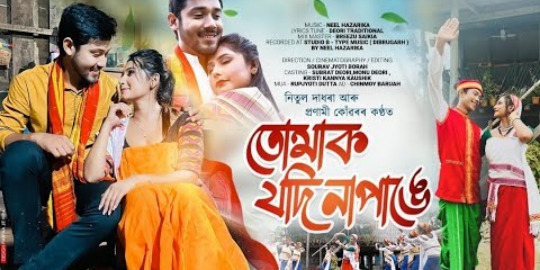
View On WordPress
#Angad Mech#Assamese Song 2022#Assamese Song Lyrics#Nitul Dadhara#Pronami Konwar#Tumak Jodi Nepange Lyrics
0 notes
Text
Tokari
After a break of more than two years, I have finally decided to write again. This time I wanted to start with something related to music, and as far as I can see myself getting butterfingered while trying (read: failing) to play instruments, I ventured on writing about an ancient instrument primarily found in Assam.
That is, a Tokari. Tokari, is said to be originated from the Sanskrit word Tonkar. Tokari’s are of different types, but the form of Tokari found in Assam looks like this –
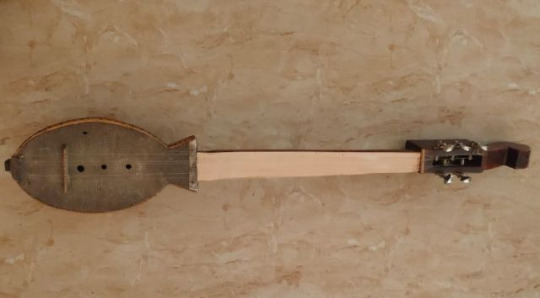
It does resemble a guitar, with a more mythological resonance into it, and particular spiritual and devotional songs related to it. The Tokari doesn't have a set date where it was found, but it had been passed down for hundreds of years, even before the Vaishnavite Movement had broke out. Srimanta Sankardeva*, a great philosopher of Assam, based his renditions of Borgeet** on the foundations of Tokari Geet (the songs related to the Tokari Instrument). According to which its a folk instrument, which is used as an accompaniment of the songs sung while playing this instrument.
Even though most of the parts of the instrument is made out of wood, the part covering the small body is essentially made out of the skin of mongoose, which is sadly, hunted down.
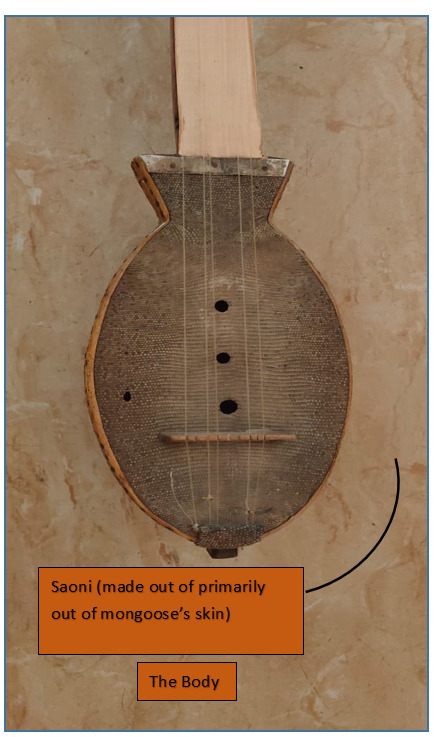
The strings are known as “Guna”, being the most important part of it, the sound emitted is very peculiar in nature, because of which the strings are tied up in a strategic manner to standardize the pentatonic notion found in music as such. Tokari is supposed to have four strings or gunas, and each guna has their own names – ing’ola, ping’ola, xuhoma, xudhoma. These strings are conjoined and grouped into two accordingly, such that they have two distinct musical scales allotted.
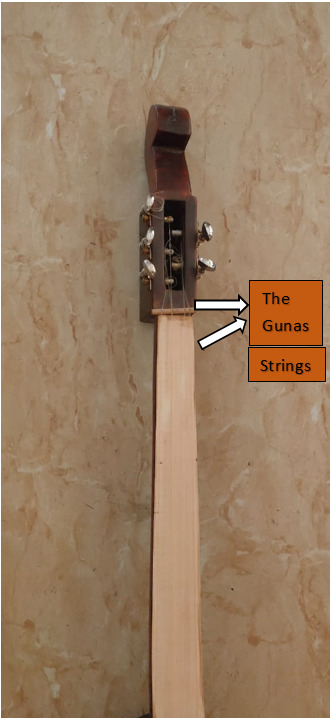
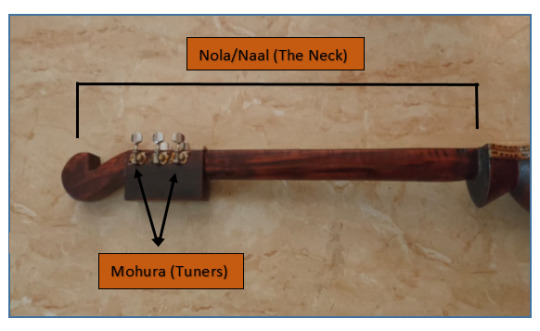
These strings are positioned at particular distances, and the tiny spaces where they are confined to are known as “Ghura” or “Saraswati”. The pick used in Tokari also needs to be of a specific size, and it’s known as the “Lakkhi."
The Tokari Geet are the songs that are sung to the rhythm and the sound of the Tokari. They have a sense of spirituality in nature, and most of all influenced by stances of Buddhism, Vaishnavism. The set of people who sings these songs are commonly known as Boiragis, and they are most often nomads, who has sacrificed whatever life they are living to their Gods.
While these songs have many nuances of Shivpurans, Doltapurans, they also talk about how the body belongs to the very material of earth, and the mysticism attached to the colossal transient system deviant of it.
Two links which you could listen to :
https://www.youtube.com/watch?v=6dikXPbsIQ
A fusion mashup - https://www.youtube.com/watch?v=Qu1QDul3Et4
*Srimanta Sankardeva - A philosopher, a dramatist, a playwright, a scholar, and a religious/cultural reformer of Assam, who also led to the advent of the extremely popular classical dance - Sattriya and a form of folk theatre - Ankia Naat.
**Borgeet - Songs which had been created specifically by Sankardeva and Madhavdeva
#traditional instruments#traditional folk#folk music#musical instruments#shankardev#assam#assamese#assamese culture#northeast india
4 notes
·
View notes
Text
Remember a few weeks ago when i posted about this alternative world i've been working on for years? Well, watching Sex Education has given me the motivation / inspiration to do something with it.
So, I'm gonna do a thing (still don't know what exactly it's gonna be?) about a bunch of teens going to this international humanities school (it's literally called World Humanities Academy), administrated by the UN in order to provide cooperation between all places in the world, that are selected randomly after presenting solicitudes to each of their countries' government.
This school, the WHA, is located on Lelu Island, off the coast of Kosrae, in the Federated States of Micronesia, and offers a very wide range of subjects concerning humanities and world affairs (a total of 148 subjects and 24 clubs / sports). Just so you understand how these subjects look like, here's an example of the 8 subjects a senior (the school is 4 years) could take plus a club they coud be in: Late Modern and Contemporary History of Central Africa [i literally just discovered the history periods are different in English and Spanish fuck], Ancient History of Micronesia, History of American Music, Philosophy, Post-classical History of Micronesia, Late Modern and Contemporary History of North Africa, Prehistory, and Uyghur Language; they could also be in the Drama Club.
They also teach Physics, Chemistry, Maths and Biology just in case, but yeah, it's mostly aimed at humanities kids. Also, every trimester they visit a different country to learn about its culture. This country is chosen randomly and they don't know about it until days before the trip, so it's always very exciting. Of course, just like the school tuition, these trips are covered by the UN. In this thing I'm doing, these are going to be the trips: in first grade they'll go to Cape Verde, Eastern Siberia, and Papua New Guinea; in second grade they'll go to Tahiti, Savoy, and Taiwan; in third grade they'll go to Twaland, Paraguay and Kashmir; and in fourth grade they'll go to Brittany, Tibet, and California.
And now, I wanted to leave here the characters I've made at the moment, so you get to see more countries and stuff. I've also associated an aesthetic / fashion style to them so you can also see their vibes and all.
So, the main character of this thing would be Adewa Owoeye. She's a bisexual trans girl from Osun state, Nigeria (it's not as big as our Nigeria tho, nearly all of the south from the border with Cameroon until Ondo state is independent), and her aesthetic is faecore (I also envision these fashion styles / aesthetics like fused with their own cultural background somehow, i can't draw but you know, i think it would be cool if they were combined).
Her best friend is Gracie Fisher. She's a straight cis girl from the London area, in England (yes, just England, no UK anymore). Her aesthetic is gremlincore.
The love interest is Mo Sharif, a cis straight guy from Wau, in South Sudan. His aesthetic is grunge.
Mo's best friend is Daudi Genzabuke-Werema, a cis gay dude from Mpanda, Western Tanzania (roughly the Tanzanian regions of Kigoma, Katavi and Rukwa), and his aesthetic is also grunge.
The mean girls of WHA are Kaavya Borgohain, a cis straight girl from South Salmara, in Assam (yes, Assam is independent), who wears traditional assamese clothing; Fern Tillman, a cis lesbian from Quartier d'Orleans, in Saint Martin (the island is unified) that has a heroin chic aesthetic; and Ru Xing (Xing Ru in the original order), a cis straight girl from an independent Macau (now a city-state) who wears preppy clothing.
The dudebros are in the hockey team, and are Tihoti Doweiya, a cis bisexual guy from Baiti, in Nauru, that has a cottagecore aesthetic; Ashraf Kaleel, a cis straight guy from the outskirts of Kuwait City, in the United Arab States (roughly comprises modern Iraq, Kuwait, Syria and Lebanon) with a cyberpunk aesthetic; and Alexander Hartjenstein, a cis straight guy from a town near Bremen, in Germany (keep in mind this Germany only comprises like the northern half of our Germany), who wears traditional countryside-like german clothing.
Apart from them, some random characters I've also made but haven't inserted into a clique or a group of friends or anything are Genca Mishaxhi, a trans asexual heterorromantic girl from the outskirts of Tirana, Albania (this Albania also includes Kosovo) who has a webcore aesthetic; Roberto Freitas, a cis bisexual guy from the island of Sal, in Cape Verde, who is a goth; Nazeer Hamdani, a cis straight guy from a town in Paktika, Pakistan (in here Pakistan is much bigger, it encompasses most of Afghanistan and part of other Central Asian states, but all of the south is independent) that rocks a bohemian style; Ranjit Chaudhari, a cis straight guy from a town in Sindhudurg, in Konkan (Konkan is basically all of the coastal area in the Indian states of Goa, Maharastra, and part of Gujarat) with a cottagecore aesthetic; and Kerry Tregonning, a cis aroace girl from St. Austell, Cornwall with a boyfriend style of clothing.
2 notes
·
View notes